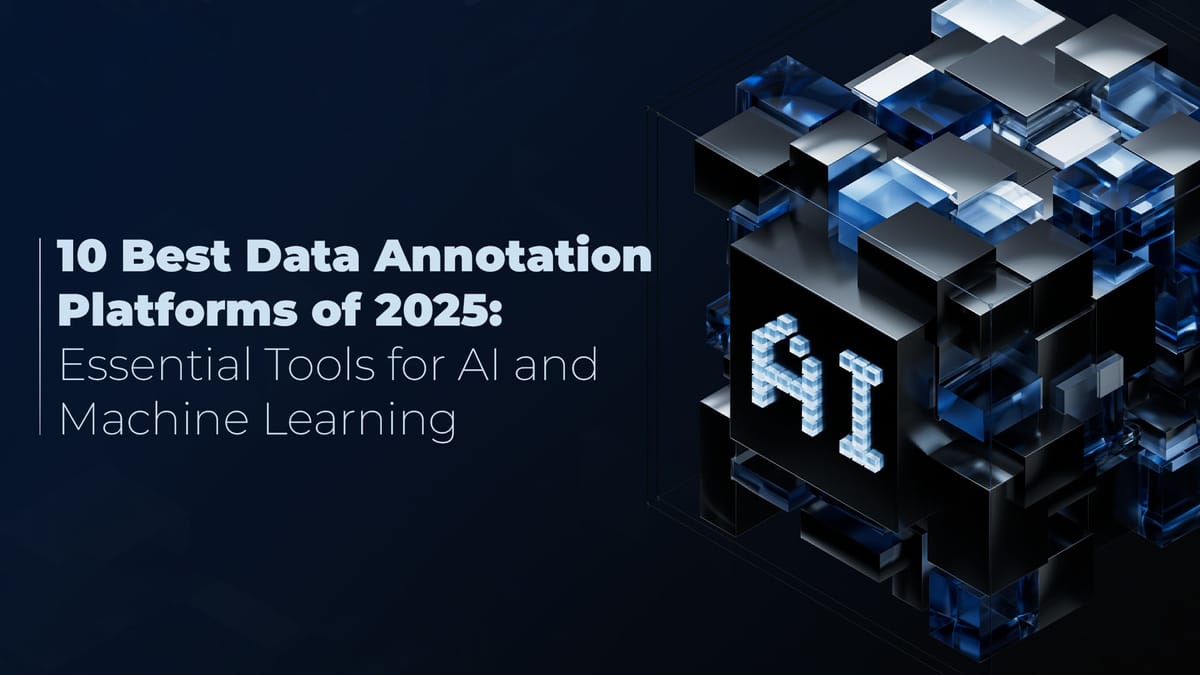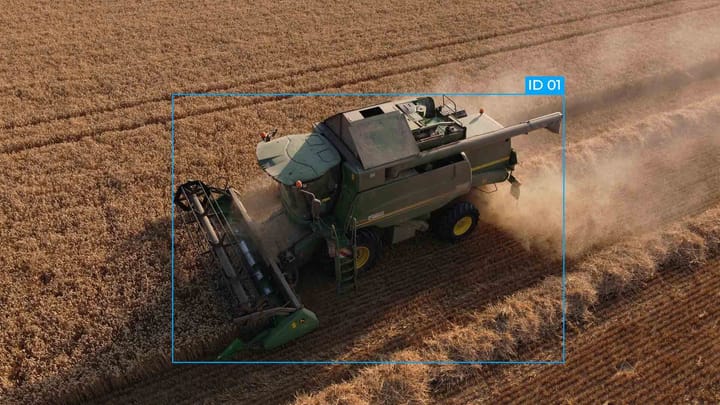10 Best Data Annotation Platforms of 2025: Essential Tools for AI and Machine Learning

With the advancement of AI, annotation platforms are doing more than just labeling data. This will create a space where accuracy, teamwork, and new ideas meet, which is essential for the future of technology.
The combination of human skills and technology is what makes annotation platforms successful. When you choose a solution, keep in mind the rapidly changing nature of the field. Quality, efficiency, and flexibility are also important.
Let's examine a list of the most reliable and effective platforms for choosing one.
The Criteria for Evaluating Data Annotation Platforms
Choose the right data annotation platform, and consider the criteria that meet your personal needs.
1. Annotation Capabilities
Make sure the platform supports the data formats you want, such as text, images, video, audio, or 3D data. Find tools such as polygons, points, semantic segmentation, bounding boxes, transcription and data labeling.
2. Platform Usability
Minimize your training time with user-friendly and intuitive interface platforms. For team coworking use tools like task assignment, version control, and commenting. You can tailor workflows, taxonomies, or annotation tools to the project's needs with customizability.
3. Data Management
Essential integration options include integrating with other AI/ML pipeline tools, cloud storage, machine learning models, and APIs. The platform should accommodate growth in data volume or annotation complexity. Also, ensure compliance with data protection regulations (e.g., GDPR) and robust security features like encryption and access controls.
4. Quality Assurance (QA)
Pay attention to the review mechanisms: built-in QA workflows, including multi-level review and consensus scoring, help annotation accuracy. Real-time tracking of annotation progress and performance metrics for QA is also helpful.
5. Workforce and Task Management
It is super pro if the platform has Human-in-the-Loop support, like integration with in-house or third-party annotation teams for tasks requiring human touch. The same situation applies to task allocation: efficient distribution of tasks based on complexity or annotator expertise.
6. Performance and Efficiency
Check the speed and ability to handle high volumes of data without compromising quality. Latency is also crucial—quick system response times are needed for real-time annotation.
7. Cost-Effectiveness analysis
Consider pricing models, such as subscription costs, pay-as-you-go plans, or pricing for large-scale projects. Save a lot of time with the help of automation or pre-trained models.
8. Platform Support and Resources
Ensure the platform has technical support, including responsive support channels and documentation. Also, necessary training resources include tutorials, guides, or onboarding programs.
9. Hybrid Approach
AI + human collaboration prioritizes platforms that combine machine learning for automation with human expertise for accuracy and context.
10. Reputation and Case Studies
Check user reviews and recognitions. Look for case studies demonstrating successful implementations in industries similar to yours.
Top 10 list
- V7
V7 is known for its easy-to-use labeling platform and powerful custom data annotation tools. The platform design is simple, so experts and newbies can use it easily. It speeds up project start-up and boosts work efficiency.
V7 has modern tools for different data types and needs. You can do semantic segmentation, object detection, and video annotation. V7's custom tools can be adjusted for any project, making data training more flexible and effective.
Special features
V7 Go turns complex documents into AI workflows, and V7 Darwin is suitable for medical imaging labeling.
- Keylabs
Keylabs is a labeling platform for images and videos that accelerates visual data preparation for machine learning. The accurate and efficient platform provides advanced features for AI developers and data scientists. You can use the platform separately or as an option included in Keymakr's (data annotation company) annotation services.
Keylabs leverages innovative tech to handle big datasets easily. The platform has an easy-to-use interface and detailed guides on how to work with it. It supports various annotation types, including cuboid, bounding box (axes aligned and oriented), segmentation (polygon and bitmask), lines and multi-lines, named points, and skeleton mesh.
Special features
Recently, Keylabs announced the launch of Keylabs 2.0, an upgraded version of its annotation platform. Powered by Segment Anything Model v2 (SAM 2) and enriched with new features, it makes annotation faster and more efficient.
- Labelbox
Labelbox offers tools for managing, annotating, and improving datasets. It simplifies the data preparation process and enhances the performance of machine learning models.
Labelbox supports seamless collaboration with flexible integration options, whether as a standalone solution or as part of broader AI workflows. It uses machine learning-assisted labeling to accelerate repetitive tasks.
Special features
Labelbox's ontology management enables teams to maintain consistent labeling structures, and its model-assisted labeling leverages AI to enhance annotation accuracy and speed.
- Prodigy
Prodigy is a tool for creating training and evaluation data for ML models. You can use Prodigy to make practice AI systems adapted to your use case, which you own and control. Prodigy integrates with spaCy, but you can use it with other libraries and tools. The library contains a variety of pre-built workflows and command line commands. Used in various everyday tasks to implement workflow actions. Optimize the web application for fast, intuitive, and efficient annotation.
Special features
Prodigy is a Python package and library with a web application. You can customize Prodigy with your Python functions and mix and match frontend components to make your annotation experience.
- SuperAnnotate
SuperAnnotate is the platform for building, fine-tuning, iterating, and managing your AI models faster with the highest-quality training data. It supports various data types, including images, videos, LiDAR, and text. With advanced annotation and QA tools, data curation, automation features, native integrations, and data governance, the platform enables enterprises to build datasets and successful ML pipelines.
Special features
You can accelerate your data gathering by customizing the interface to support any GenAI task, from Supervised Fine-Tuning SFT to Retrieval-Augmented Generation RAGand fine-grained Reinforcement learning from human feedback RLHF.
- Dataloop
Dataloop is an AI development platform that empowers data practitioners to collaborate and build AI solutions. The platform offers a large marketplace of models, datasets, ready-made workflow templates, etc. It is well-integrated with various cloud platforms and data tools. Dataloop helps automate processes important for AI development, such as model training, human feedback (for RLHF and Active Learning), etc.
Special features
Each part of the pipeline can be created, modified, and deleted using an API call. The Python SDK gives you complete control over data pipelines to build AI applications.
- DataTurks
DataTurks offers a straightforward data labeling platform to speed up the annotation process. The platform makes tasks such as text, image, and video annotations easy and suitable for various applications. In addition, the platform integrates machine learning to improve performance and accuracy. It allows teams to annotate large data sets better. With special tools, it can handle different data types, which is helpful for various AI projects.
Special features
Use DataTurks to track your model's production continuously by uploading the raw data. Your labeling team validates it and generates the correct figures.
- Roboflow
Roboflow is a data annotation platform that helps users build their computer vision models. It includes tools for image annotation, training models, and dataset organization. The platform supports automatic data completion, allowing diverse datasets from limited data. It also has an easy-to-use interface with advanced features like version control for models and datasets. Roboflow is especially attractive for computer vision tasks like object detection, classification, and segmentation.
Special features
It is one of the most popular annotation platforms, and over one million engineers use it to create datasets, train models, and deploy them to production.
- Segments.ai
Segments.ai — is a fast and accurate multi-sensor data labeling platform for robotics and autonomous driving. You can get segmentation labels and vector labels. The platform also has intuitive labeling interfaces for images, videos, 3D point clouds (lidar and RGBD), 2D images, a batch mode for labeling dynamic objects, and a merged point cloud mode for stationary.
The platform gives consistency with synchronized time and modality tracking identifiers.
Special features
To create clear, comprehensive annotation instructions, Segments.ai offers a free tutorial for creating markup instructions. In it, you'll learn why a transparent process is essential, what elements you need for a better process, and tips and tricks for improving your labeling instructions.
- Unitlab
Unitlab is a collaborative AI-powered data Annotation Platform offering on-premises solutions and integrated labeling services. It automatically collects raw data and enables collaboration with human annotators to produce highly accurate labels for machine-learning models. Unitlab Annotate helps you optimize data annotation work efficiency, control annotation quality, and minimize costs.
Special features
You can get the full functionality of Unitlab on your servers or in the private cloud. Unitlab promises to seamlessly integrate workflow and process management into the existing on-premise environment.
Summary
Annotation platforms are an integral part of the machine learning industry. They support various types of data (text, images, video, 3D). Among the market leaders are V7, Keylabs, Labelbox, SuperAnnotate, Roboflow, and others. These platforms include a variety of annotation tools, a user-friendly interface, the ability to work in teams, and integration with other systems.
All this makes data annotation reliable, accurate, and more affordable in price and quality. Therefore, these platforms are important for the fields of autonomous driving, medicine, computer vision, and text analysis.



Comments ()